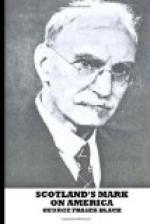Sir William Johnson for his services in the French War (1755-58) received from the Crown a grant of one hundred thousand acres in the Mohawk Valley, near Johnstown, which he colonized with Highlanders in 1773-74.
In New York City about the end of the eighteenth century there was a colony of several hundred Scottish weavers, mainly from Paisley. They formed a community apart in what was then the village of Greenwich. In memory of their old home they named the locality “Paisley Place.” A view of some of their old dwellings in Seventeenth Street between Sixth and Seventh Avenues, as they existed in 1863, is given in Valentine’s Manual for that year.
Although many Scots came to New England and New York they never settled there in such numbers as to leave their impress on the community so deeply as they did in New Jersey, Pennsylvania, Delaware, and the south. There were Presbyterian churches in Lewes, Newcastle (Delaware), and Philadelphia previous to 1698, and from that time forward the province of Pennsylvania was the chief centre of Scottish settlement both from Scotland direct and by way of Ulster. By 1720 these settlers had reached the mouth of the Susquehanna, and three years later the present site of Harrisburg. Between 1730 and 1745 they settled the Cumberland Valley and still pushing westward, in 1768-69 the present Fayette, Westmoreland, Allegheny, and Washington counties. In 1773 they penetrated to and settled in Kentucky, and were followed by a stream of Todds, Flemings, Morrisons, Barbours, Breckinridges, McDowells, and others. By 1790 seventy-five thousand people were in the region and Kentucky was admitted to the Federal Union in 1792. By 1779 they had crossed the Ohio River into the present state of Ohio. Between the years 1730 and 1775 the Scottish immigration into Pennsylvania often reached ten thousand a year.




